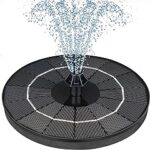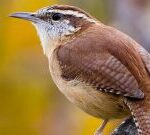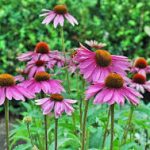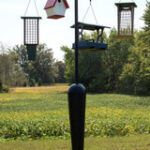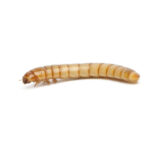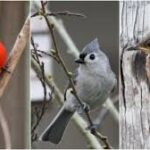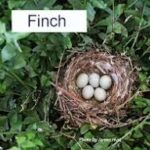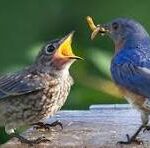I gave Nancy a Solar Fountain for the front yard birdbath for Christmas as a small gift for Christmas last year, but since it was winter, we put it away – and forgot about it. A couple weeks ago, Nancy found it, we assembled it and put it in the birdbath. It’s great – keeps the water fresh and stirred up and mosquitos at arm’s length. Plus, the birds love it. It’s like taking an outdoor shower … [Read more...]
Wren-field: The Real Spider Man
Recently, during a rare downpour, I saw “Wren-field” pecking away on the window ledge. He had found a juicy spider. Wren-field is the name I have given to my resident Carolina Wren. He, or one of his ancestors, has called our yard home every year we’ve been living at 214 Brentwood Road. While we’ve only lived in one house for the last 50 years or so, Wren-field has had many houses – sometimes … [Read more...]
The Moocher and the Mother
I have two catbirds that visit me when I go out on the patio with a bowl of wiggly meal worms. One is the Moocher and the other is the Mother. Though both birds are identical in appearance, I can easily tell the mother bird. When I toss a few meal worms her way, she puts each one carefully in her beak (her best score is 10 mealworms in one mouthful) then flies around the side of the house and … [Read more...]
Oh No, Not Another Nest
My backyard bluebirds had nested twice. I know that at least 2 chicks survived the first ordeal and one bird made it after the second nest. They had replaced themselves, plus one. That’s good. Let it go. But I heard that distinctive chirping from the male, meaning, “Hey babe, let’s get it on again.” And they did. The hen is now warming up 3 or 4 more eggs, though they chose a different house … [Read more...]
Lovely and Versatile Conefllowers
Nancy has done some amazing work landscaping our yard. About all I do is mow the grass and sit back and enjoy the lovely flowers and plants, so I take no credit. One of my favorite parts of the yard, though, is a little wildflower patch around our bird bath. There was once ivy there, that took over everything, but Nancy pulled it all up and planted a little patch of perennials that includes … [Read more...]
A Bird Buffet
For Father’s Day, I got a Squirrel Stopper Sequoia – a fancy term for a bird buffet. It’s an elegant bird feeder pole that features 4 hanging stations. It’s a sturdy piece of equipment that will hold fairly heavy feeders, bird houses or plants. The lower pole segment has an attached auger that will screw into the ground about 2 feet, making this pole system strong and secure. The middle section … [Read more...]
20,000 Meal Worms
(1 of 20,000) I have now ordered 20,000 meal worms from Fluker Farms. I fully expect that amount will last me through the season. My bluebirds have produced two nests and my goal is to supplement the hard-working creatures while they try to feed many hungry beaks. In past years, I have run out of meal worms at the end of the season and have had to buy them from local pet shops, and … [Read more...]
Birds of a Feather
Not only do they flock together, they feed together. All of them. At the same time. My passion is watching birds, sometimes from the kitchen window and sometimes from my vantage point in a lawn chair in the back yard. One thing I have noticed is that all the birds seem to feed at the same time. You’ll see bunches of birds – cardinals, sparrows, chickadees, finches, and the like, then they will … [Read more...]
Fern Finches
I bought Nancy a couple potted plants to hang on the front porch. They were ferns and they were about seventeen bucks each – much higher than we used to pay, but they worked. After a couple attempts at getting the screw hook imbedded in the porch roof and a mending of the wire that held the heavy plants, all was well. Then, a couple weeks ago, it called for rain, so Nancy decided a little … [Read more...]
Four Baby Blues
Our resident bluebirds pulled off a successful hatch a couple weeks ago. As usual, when the chicks fledged, they were immediately escorted by their parents to some tall trees behind out house – far away from blue jays, crows and squirrels that visit our yard. I never knew how many babies made it until this week. They are now reaching full size and there are four still alive and kicking. In all my … [Read more...]
- 1
- 2
- 3
- …
- 43
- Next Page »
